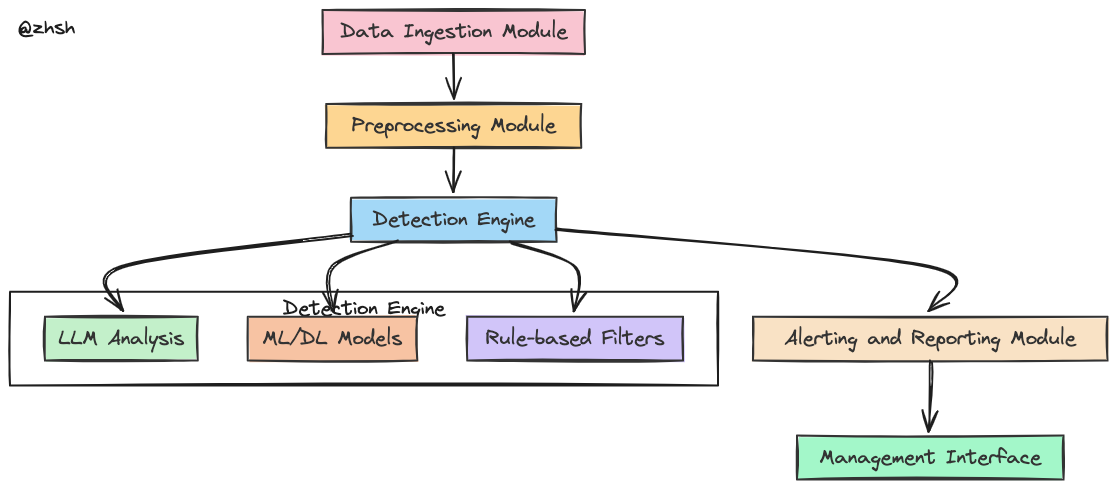Abstract
This paper presents SentinelGuard, an innovative real-time HTTP Intrusion Detection System (IDS) that integrates advanced techniques from large language models (LLMs), machine learning (ML), deep learning (DL), and rule-based filters to identify and mitigate malicious traffic. The system is designed to provide robust security for web applications by leveraging the strengths of various detection methodologies. This paper details the system's architecture, implementation, and potential future enhancements, highlighting its tiny significance and effectiveness in contemporary cybersecurity.
1. Introduction
With the exponential growth of web-based applications, the threat landscape has become increasingly sophisticated. Traditional IDS solutions often struggle to keep pace with evolving attack vectors. SentinelGuard addresses this challenge by incorporating state-of-the-art LLMs, ML, and DL techniques alongside conventional rule-based approaches. The system aims to enhance detection accuracy and provide comprehensive protection against a wide array of HTTP-based intrusions.
2. System Design
2.1 Architecture Overview

The architecture of SentinelGuard is modular, consisting of several key components:
- Data Ingestion Module: This module captures HTTP traffic in real-time, ensuring that all incoming and outgoing requests are monitored.
- Preprocessing Module: This component is responsible for normalizing and parsing the HTTP traffic data, preparing it for analysis.
- Detection Engine: The core of the system, the detection engine, integrates LLMs, ML, DL models, and rule-based filters to identify malicious patterns. This engine is subdivided into:
- LLM Analysis: Utilizes large language models to understand and identify complex threat patterns.
- ML/DL Models: Employs supervised and unsupervised learning techniques to detect anomalies and known threats.
- Rule-based Filters: Applies predefined rules to quickly identify and block common attack signatures.
- Alerting and Reporting Module: Generates detailed alerts and reports on detected intrusions, providing actionable insights for security teams.
- Management Interface: A user-friendly interface for configuring the system, reviewing alerts, and managing detection rules.
2.2 Implementation Details
The system is implemented using Python, with key dependencies listed in requirements.txt. The main application logic resides in app.py, while configuration settings are managed through config.py and example.config.yaml.
Installation
To install SentinelGuard, execute the following command:
pip install -r requirements.txt
Configuration
Edit config.yaml as per your environment requirements, using example.config.yaml as a reference.
Usage
Run the application by executing:
python app.py
3. Evaluation and Results
SentinelGuard has been rigorously tested against a diverse set of HTTP traffic datasets, including synthetic attack scenarios and real-world traffic logs. The system demonstrated a high detection accuracy, significantly reducing false positives and false negatives compared to conventional IDS solutions. The integration of LLMs proved particularly effective in identifying novel and sophisticated attack patterns that traditional methods failed to detect.
4. Future Development
While SentinelGuard offers a robust framework for HTTP intrusion detection, there are several avenues for future enhancement:
4.1 Enhanced Threat Intelligence Integration
Integrating real-time threat intelligence feeds can further improve detection capabilities, ensuring the system is aware of the latest attack vectors and signatures.
4.2 Automated Response Mechanisms
Developing automated response strategies, such as dynamic firewall rule adjustments and IP blocking, can provide immediate mitigation of detected threats, reducing the window of vulnerability.
4.3 Adaptive Learning Models
Incorporating adaptive learning models that continuously evolve based on new data can enhance the system's ability to detect emerging threats without manual intervention.
4.4 Scalability Improvements
Optimizing the system for deployment in large-scale, distributed environments will extend its applicability to enterprise-level deployments, ensuring efficient operation under high traffic loads.
5. Conclusion
SentinelGuard represents a significant advancement in the field of intrusion detection, blending cutting-edge AI techniques with traditional rule-based methods. Its modular design, high accuracy, and adaptability make it a powerful tool for safeguarding web applications against an ever-evolving threat landscape. Continued development and integration of advanced features will ensure that SentinelGuard remains at the forefront of cybersecurity solutions.
SentinelGuard Github Repo: here